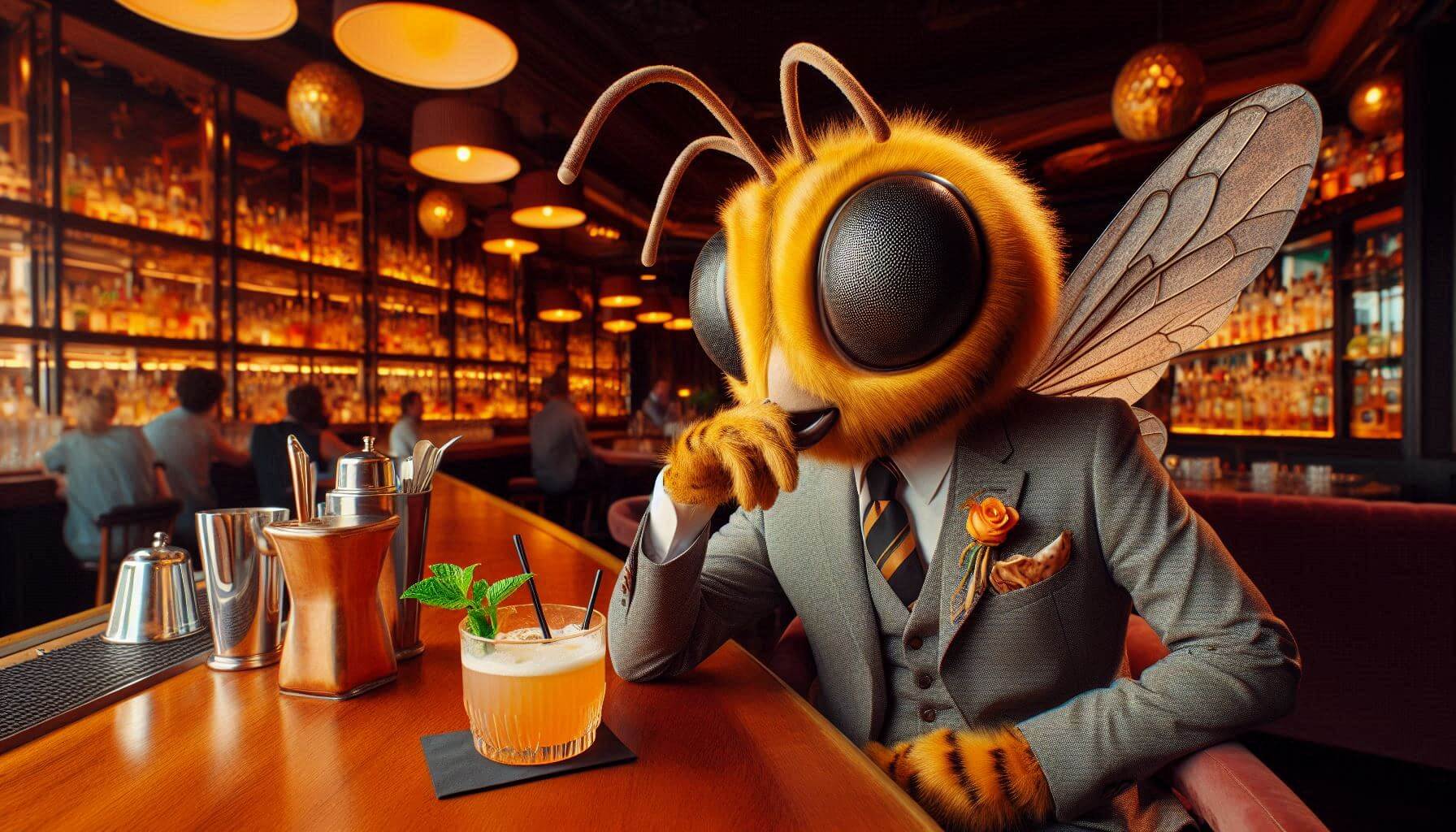Drink Donnybrook: Bee’s Knees
by David Klemt

That is one dapper bee, my friends.
The subject of our latest Drink Donnybrook deep dive is the Bee’s Knees, a classic that has very likely already enjoyed its centennial birthday.
If that sounds a bit uncertain, welcome to your first Drink Donnybrook article. I tend to cover cocktails with origins that are, shall we say, less than definitive.
In the case of the Bee’s Knees, we simply don’t know without a doubt the drink’s creator. Nor do we know exactly which year the cocktail came into being.
One compelling piece of evidence that ties the Bee’s Knees to the 1920s is the name itself. The term “the bee’s knees” became part of the American lexicon in that decade. To this day, if someone calls something or someone “the bee’s knees,” they’re saying it’s excellent
Another piece of evidence is Prohibition in America. So-called (let’s face it, largely aptly named) “bathtub gin” became ubiquitous during this time. As the story goes, honey was an ingredient that could cover up the smell of cheap (and likely dangerous) alcohol, like bathtub gin.
Well, the Bee’s Knees is a gin cocktail with honey and lemon juice among the ingredients. Honey and lemon juice can certainly make a poor-quality potable more palatable.
Alright, so those are two solid clues that support the belief that the cocktail is from the 1920s. The drink could be a bit over 100 years old, turning 100 this year, or a few years away from reaching the hundred-year milestone.
Accepting the time period, who do we give credit for creating the Bee’s Knees?
A French Connection
There are two strong candidates for the title of “Creator of the Bee’s Knees.”
One is Frank Meier, who became the head bartender at the Ritz Hotel in Paris in 1921. Click here for a bit of information tying Meier to the Mimosa.
Meier was, undoubtedly, a prolific cocktail craftsman. One need simply sift through his 1936 recipe book, The Artistry of Mixing Drinks, to see the breadth of his work with spirits.
There’s an important detail on the pages of that book that lend support to the theory that Meier created the Bee’s Knees. If you clicked the link a few sentences above, you’ll know what I’m talking about.
There’s a symbol—a diamond with “FM” inside of it—next to certain drinks. As page 20 of the book explains, a drink that has this symbol beside it was created by Meier. The Bee’s Knees is marked with that symbol, while the Mimosa is not.
However, there’s another French connection that may have created this gin-based classic.
If you’re familiar with your Titanic history, the name “the unsinkable Molly Brown” may ring a bell. In 1912, Margaret Tobin Brown was one of the 712 people who survived the sinking of the Titanic.
It’s said that Brown, a wealthy widow and socialite, spent time traveling. Often times, these journeys and adventures found in her Paris. An article published in The Standard Union in 1929 addressed the topic of “women-only bars.” That same article claimed that Brown invented the Bee’s Knees while visiting these drinking establishments.
Personally, I find the story that Meier created the Bee’s Knees to be the most probably. But I’d love to learn that a Titanic survivor gifted us with a classic that has stood the test of the time.
Cheers!
Bee’s Knees
- 2 oz. London Dry gin
- 0.75 oz. Fresh-squeezed lemon juice
- 0.5 oz. Honey syrup
- Lemon twist to garnish
This is an easy one, once you have your honey syrup sorted. On that topic, different honeys will imbue this cocktail with vastly different flavor profiles. So, you’ll want to experiment with honeys to come up with your signature. I recommend starting with something local. Of course, the same can be said for gin, so this one needs plenty of testing.
In a shaker, add the first three ingredients and ice. Shake well, strain into a chilled cocktail glass, and garnish.
There are variants, which will likely come as no surprise. There’s a version from 1948 that calls for a splash of orange juice. Swap out the London Dry gin for light rum to make a Honeysuckle. Substitute Jamaican rum and you’ve got a Honey Bee. And if the drink is made with Old Tom gin rather than London Dry, it’s a Cat’s Whiskers.
Image: Microsoft Designer

